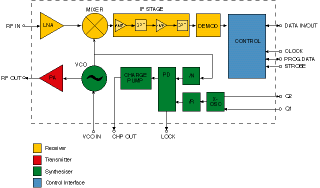RF transceiver chip for 868/915 MHz SRD band
28 February 2001
Telecoms, Datacoms, Wireless, IoT

Chipcon Components is continuing the success of its CC400 RF transceiver (for use from 300-500 MHz) by introducing the CC900 RF transceiver for the 800-1000 MHz band. The CC900 is a one-chip FSK radio transmitter and receiver intended to be used in the license-free 868 MHz and the US 915 MHz, SRD band. It can be used in all the different frequency bands around 868 MHz and fulfils the requirements for 25 kHz channel spacing.
It has the capability of FHSS. A frequency resolution down to 250 Hz makes crystal temperature compensation possible with no external TCXO. The range is up to 500 m and data rates up to 9,6 kbps. Output power is programmable from -20 to 4 dBm and the receiver sensitivity is -110 dBm for BER 10e-3 at 1,2 kbps. The receiver current consumption is 23 mA at 3 V supply voltage and in power down mode it consumes only 0,2 µA.
Chipcon Components also provide the SmartRF Studio software for the CC900, where all the necessary configuration data is generated in a format that is easily included in any microcontroller code. A development kit is available and a demonstration kit for the CC900 RF transceiver will be available soon.
Further reading:
What does Wi-Fi 7 mean for South African networks?
Telecoms, Datacoms, Wireless, IoT
With Wi-Fi 7 (802.11be), we are finally looking at a standard that was built, not just for more devices, but for the new way networks are used.
Read more...
Multiprotocol wireless SoC
RF Design
Telecoms, Datacoms, Wireless, IoT
The nRF54LM20A from Nordic Semiconductor is a multiprotocol wireless System-on-Chip designed for demanding designs in Bluetooth devices.
Read more...
High performance communication
iCorp Technologies
Telecoms, Datacoms, Wireless, IoT
Quectel’s FCS950R is a high-performance Wi-Fi 5 and Bluetooth 4.2 module that can deliver a maximum data rate up to 433,3 Mbps in 802.11ac mode.
Read more...
Expanded STM32WL3x line for IoT sensors
Altron Arrow
Telecoms, Datacoms, Wireless, IoT
The STM32WL31x and STM32WL30x are more tailored versions of the STM32WL33x for designers who wish to focus on specific features, while lowering their bill of materials.
Read more...
Full-band GNSS helical antenna
RF Design
Telecoms, Datacoms, Wireless, IoT
A key feature of Calian’s HC3990XF antenna design is that it does not require a ground plane, making it ideal for size-constrained applications.
Read more...
BLE and BT Mesh module
iCorp Technologies
Telecoms, Datacoms, Wireless, IoT
The HM-BT4531 from HOPERF is a BLE data transmission module that features an ARM Cortex-M0 32-bit processor.
Read more...
Espressif entering the Wi-Fi 6E market
iCorp Technologies
Telecoms, Datacoms, Wireless, IoT
Espressif Systems is entering the Wi-Fi 6E market, extending its connectivity portfolio into the domain of high-throughput, low-latency wireless solutions.
Read more...
Ultra-low jitter clock buffers
Altron Arrow
Telecoms, Datacoms, Wireless, IoT
New SKY53510/80/40 family of clock fanout buffers from Skyworks are purpose-built for data centres, wireless networks, and PCIe Gen 7 applications.
Read more...
Cutting-edge broadband power amplifier
RFiber Solutions
Telecoms, Datacoms, Wireless, IoT
Designed for high efficiency and reliability, the WPGM0206012M from WAVEPIA is a cutting-edge broadband GaN MMIC power amplifier operating from 500 MHz to 8,5 GHz.
Read more...
The trends driving uptake of IoT Platform as a Service
Trinity IoT
Editor's Choice Telecoms, Datacoms, Wireless, IoT
IoT platforms, delivered as a service, are the key that will enable enterprises to leverage a number of growing trends within the IT space, and access a range of benefits that will help them grow their businesses.
Read more...


